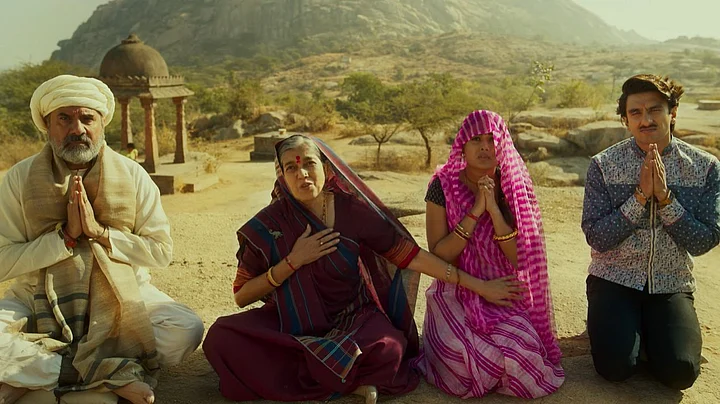In the past two weeks, debate over abortion laws in the United States have dominated social media conversations around the world, including in India. While criticising the repressive abortion laws of the US, Indians were keen to praise the seemingly progressive laws on abortion in our country.
However, in this clamour about whose laws are more progressive, we forgot India’s troubled history with sex-selective abortion. The Indian government made it illegal to reveal the sex of an unborn child way back in 1994, with the passage of the Pre-Conception and Pre-Natal Diagnostic Techniques Act. However, 27 years on, the practice is very much a part of our present.
It is this very issue that the Ranveer Singh-starrer Jayeshbhai Jordaar takes on. The film begins with a scene in a gynaecologist's cabin where Jayesh's family has gathered. His wife Mudra, played by the adaptable Shalini Pandey, is pregnant – and the family is keen to know the sex of the foetus.
It is no secret that Mudra’s father-in-law and sarpanch Pruthvish (played by Boman Irani) and mother-in-law Jashoda (Ratna Pathak Shah) want a grandson – to keep their so-called family line growing. They simply, casually want to know the sex of the foetus.
While the gynaecologist says that it is not possible to determine the sex at the moment, she stresses that it would be risky for Mudra to have a seventh abortion – since the birth of her first child Siddhi, played by the charming Jia Vaidya.
The doctor, however, slyly informs Jayesh that the foetus is female – with the code words Jai Mataji. While all of it is happening, you see a disclaimer that pre-natal sex determination is a criminal offence written in white font, barely visible to the audience. Just like the disclaimer, the film, too, barely addresses the deep-rooted problem of sex determination.
Mudra Reduced to Persona Non Grata
We barely get to know anything about Mudra. We don’t get to know her thoughts and views on sex-selective abortion, or what her body could have/would have gone through the six times she got them.
It is only when Mudra’s life is at stake if one more abortion would be performed, that Jayesh thinks about standing up to his parents. Suddenly, conscience is awake, and he starts to think of ways to protect his daughter and wife.
Ranveer’s character is portrayed as a sensitive man, one who ‘truly loves’ his wife. Because he does not beat his wife (even when asked to do so) and adores his daughter Siddhi. We are asked to ignore his role in the previous abortions. It is downplayed and presented as ‘familial pressure.’
Siddhi is considered lucky as she was ‘allowed’ to be born. The rest are not so lucky – no questions asked.
Women Don’t Make Reproductive Decisions
However, by making Mudra persona non grata, the film also brings to light the fact that women barely make reproductive decisions in India. The decision to abort the six foetuses is not made by Mudra, but by her in-laws.
Similarly, the decision to not abort the seventh pregnancy is also not made by her, but by Jayesh. The film is successful in portraying the involvement of the family and society in the reproductive choices of women but not themselves.
The film could have taken a much stronger position on sex-selective abortions. It fails to go beyond the message that women should not be killed before birth because of their value as wives and/or mothers.
For instance, even Jayesh is shown to tell his mother at one point that if her parents had not given birth to her, he, too, would not have been born. But sex-selective abortion is not wrong because we would fall short of wives and mothers. It is wrong because it is sex-selective.
Jayeshbhai Jordaar reduces women to just the identities of mothers, sisters, and wives.
Filed With Tired Tropes
The second half of the movie, particularly, takes a dramatic turn when Jayesh’s escape plan to Ladopur – a fictional village in Haryana – gets foiled. He is forced to get married for the second time – and it becomes all too predictable from here on.
By the end of it, Jayeshbhai Jordaar takes on a very preachy tone where 'hope' is presented as a realistic ideal. Jayesh gives a long speech to the women of the village – that there is no point in escaping to Ladopur because otherwise what will happen to the men? – left me confounded.
The movie thus reproduces a popular trope often present in Bollywood movies – placing the burden of changing or rehabilitating men (and society) on women. Jayesh argues that it is not their mistake because their actions are based on their socialisation.
However, it downplays the role that everyone, including Jayesh himself, has played in the criminal offences of pre-natal sex determination and abortion of female foetuses.
While the film tackles an important issue, it has failed to come out of prevailing stereotypes and tropes. There is too much pressure on Jayesh to be the saviour and jordaar, which he fails to do in many instances.
(The author is a sociologist by training and teaches Sociology at Indraprastha College for Women (IPCW), University of Delhi. She is also one of the co-founders of Doing Sociology. This is an Opinion article and the views expressed are the author's own. The Quint neither endorses nor is responsible for them.)
